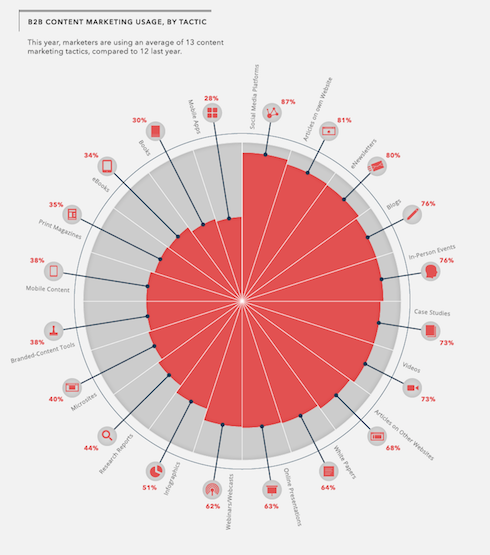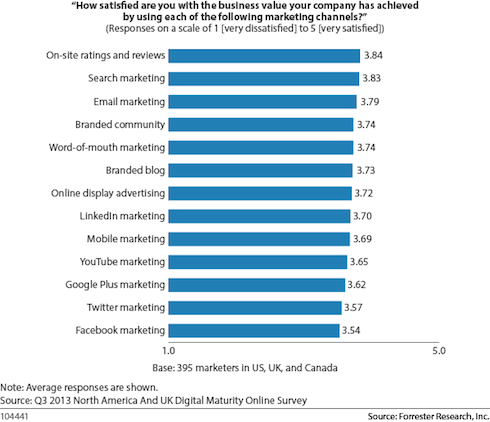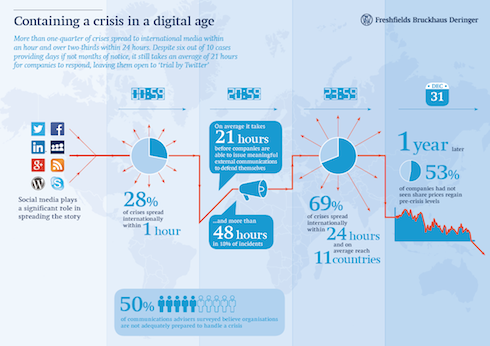By adaptive - November 6th, 2013
Google+ gets visual, marketers continue to embrace social but Facebook continues to disappoint
Marketers confident about social media
According to new research from LinkedIn that they have encapsulated in their new infographic, 87% of content marketers are using social media as a core component of their campaigns. If your corporation is in the B2B sector, social media is clearly now a legitimate channel for marketing campaigns.
It is also interesting when the kind of content that is being used by marketers is considered. According to this research 34% use e-Books, nearly 30% mobile apps, and just over a third still using print media. The core of the messages was still brand awareness, with events and case studies being the most popular types of content to use across the social channels to connect brands with their customers.
However, research by Maxus for Business shows that B2B brands still need to pay more attention to social media to leverage their messages. According to their research 70% of respondents stated they believed B2B brands don’t understand how to communicate via social media channels.
“Luckily for B2B marketers, this survey shows that business people are keen to hear from relevant brands,” said James Bailey, head of Maxus For Business. “However, some brands could benefit from improved targeting and perhaps sometimes a better understanding of the day-to-day realities of busy, time-poor executives’ working lives.”
The B2B sector has been characterised by a slow uptake of social media usage. However, brands are waking up to what social media can do for them when communicating with their commercial partners. Now it’s time for B2B brand owners to move their use of social media into their mainstream marketing activity.
Google+ gets visual
Google has unveiled a slew of new features for its social media service, with many of them placing more visual functionality into the hands of users. Improvements to Auto Awesome for photo editing, and an improved Instant Upload for iOS, as well as HDR controls for Snapseed, showed a clear move towards visual marketing across Google+
And it appears that visual content is on the rise with Google claiming 1.5 billion photos are uploaded to the site each week, which now sports 540 million users. What is clear is that Google+ is out performing even Facebook with visual material. Facebook has links to Instagram that has delivered over a billion more image uploads than Google+, but it’s impressive that Google+ has been able to achieve its massive upload numbers with little or no help from other networks.
It is still early days yet for Google+ but it’s clear that it has big plans to become a visual market place. The success of Pinterest has not been ignored by Google that sees visual marketing as the next big thing, especially if you factor in the massive rise of m-commerce.
Facebook is failing marketers
In an open letter to Facebook CEO Mark Zuckerberg, Forrester has outlined its research that reveals that the social media leviathan is actually offering little return to marketers. Forrester’s Nate Elliott, VP and Principal analyst states: “While lots of marketers spend lots of money on Facebook today, relatively few find success. In August, Forrester surveyed 395 marketers and eBusiness executives at large companies across the US, Canada and the UK — and these executives told us that Facebook creates less business value than any other digital marketing opportunity.
“Your company isn’t good enough at the pure advertising business onto which you’ve shifted your focus. We estimate your site now delivers tens of billions of display ads every day. But fewer than 15% of those ads leverage your ever-growing cache of social data to target relevant audiences. And your site’s static-image ad units offer marketers less impact per impression than they could achieve with the ad units other sites offer.
“The result? The executives we surveyed said Facebook’s display ads were significantly less effective than the display ads they buy elsewhere online. They also reported that Facebook ads were less valuable than any other marketing tactic they could use on your site.
“I believe there’s still time for Facebook to refocus its efforts and realize its enormous potential. To do that, you’ll need to once again build bridges between companies and their customers, you'll need to fully leverage social affinity data within your ad targeting products, and you'll need to better listen to the marketers who drive your company’s financial success.”
Facebook still managed to collect more than $4 billion in ad revenue last year, but the platform must do more to support marketers. However, simply focusing on the Facebook component is misleading. Facebook should be just one component of a large marketing strategy to leverage social media to deliver brand awareness and corresponding marketing messages.
The clock is ticking
There is a growing trend where the first point of contact a customer has with a business for a customer service query is via their favourite social media network. New research from Khoros has revealed that response times have continued to shorten.
Customers have high expectations for a quick response: 53% of respondents expect a brand to respond to their Tweet query in less than an hour. If the contact is for a complaint, the number increases to 72%. If these demands are not met, over a third of respondents to the survey commissioned by Millward Brown Digital will have a negative response to the brand, with 60% expressing this across their social networks.
“It’s time for brands to wake up and realize that social response is the new real-time marketing,” Lithium President and Chief Executive Officer Rob Tarkoff said. “Brands must meet their customers in their venue of choice – Twitter – and a slow or silent response simply isn’t an option. With 57% of consumers unlikely to spend with you again after a negative experience, those could be the most expensive 140 characters a brand ever ignores.”
Millward Brown Digital Senior Vice President, Media Practice Michael Perlman said: “Twitter has evolved into a preferred method for communicating with brands and has the potential to grow even further. Brands need to be prepared for the rapid shift taking place in consumer expectations regarding social response.”
In a related study from law firm Freshfields Bruckhaus Deringer, brands were shown to have a response time of 21 hours after a crisis on Twitter erupted, rising to 48 hours in 18% of incidents. Julian Long, a corporate partner and crisis management expert at Freshfields said: “Until recently, responding to a crisis by initiating a thorough investigation bought companies a little bit of time to agree a fuller response with management and the company’s legal advisers. Today, largely as a result of the growth in social media use, the window to buy more time has virtually disappeared. The moment a negative story breaks it has the potential of spreading like wildfire to the other side of the world.”
“Failing to prepare for a crisis, no matter how unlikely it may seem, is really no excuse, particularly given that crises that genuinely come out of the blue tend to be the exception. The nature of social media means that all those at the coal face of managing a crisis: company executives, lawyers and communications advisors, have to adapt to what is a considerable new challenge.” With the report finding that a quarter of crises spread internationally, and two-thirds within 24 hours, taking preventative action now is a commercial imperative no corporation can ignore.
Until next time….
The Useful Social Media team.
Next Reads
December 2013, London
Become a social business: For superior marketing response, sharper corporate decision-making, enhanced innovation and a happier, more loyal customer
Brochure Programme


